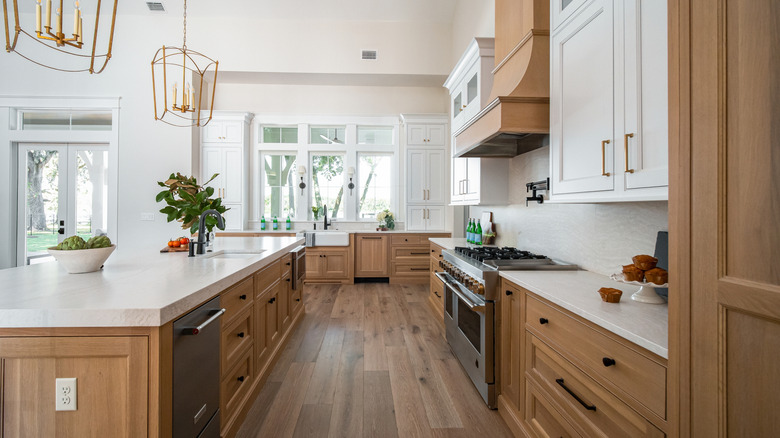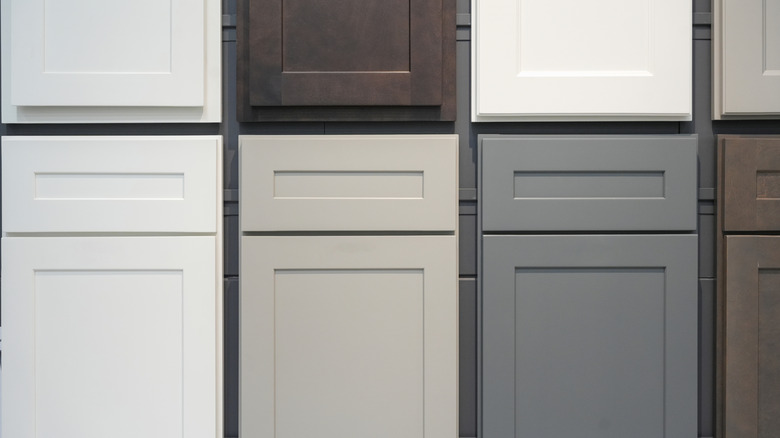The Major Downside Of Thermofoil Cabinet Doors You Should Definitely Consider
Kitchen cabinets have come a long way from the days of limited options of wood and painted wood. These days, kitchens boast all kinds of materials — from varying species of wood to the sleek modern trend of metal cabinets. Choosing between the options isn't always easy, especially when you're considering thermofoil and other lesser-known materials. Thermofoil cabinets were introduced in the 1980s as a cost-effective alternative to heavily painted cabinets, which were quite expensive back then. They're a popular choice for high-traffic areas as they're chip- and water-resistant. However, there is a major downside to thermofoil — its vulnerability to heat.
Thermofoil's vulnerability stems from the material it's made from. The outer surface is a layer of vinyl that is heated, pressurized, and vacuum-sealed over a piece of medium-density fiberboard (more commonly known as MDF). MDF isn't immune to moisture, nor are other wood cabinets, which will warp if too much moisture is introduced. So, thermofoil is the protective coating around these more delicate materials to prevent this from happening. Despite this vinyl being protective in nature, it has a major weakness when it comes to heat.
The downside of thermofoil cabinets
Appliances like ovens produce a significant amount of heat — enough to affect the structural integrity of thermofoil cabinets nearby, which have a lower heat tolerance compared to wood. Typically, smaller appliances like microwaves aren't going to produce enough heat nor be on long enough to damage your thermofoil, but when high temperatures are introduced to this material for extended periods of time, even via steam from a long dishwasher cycle, you have to deal with melting, peeling, blistering, and delamination of the vinyl from the door.
Your stove is thermofoil's biggest adversary because of the immense heat, but there is a way to enjoy cooking without immediately melting your cabinet fronts. Heat shields, protective metal edging acting as a barrier between high-heat appliances and cabinetry, are designed to absorb and dissipate heat to extend the life of your thermofoil cabinets.
When damage is done anyway, refacing the cabinet door is your smartest option since the material can't be stuck back on without going through the original process of heating, pressurizing, and vacuum sealing. If you have very small areas that are compromised, applying contact cement and clamping the thermofoil down onto the MDF will suffice as a short-term solution. You can also reface your cabinets yourself without breaking the bank if you're hesitant to hire a professional.
Alternatives to thermofoil cabinets
If the idea of heat-damaged thermofoil cabinets needing such tedious repairs has caused you to reconsider them, there are a plethora of other options available to meet your needs, style preferences, and budget. Stained or painted wood cabinets have been around for decades and for good reason — they're dependable and relatively easy to maintain. They're not immune to issues, though. Chips in the paint and warping of the wood from heat can happen. Metal, although pricier, is going to withstand heat and stains, while being easy to clean and eye-catching.
A timeless white kitchen design will make your dollars stretch further than if you went with something trendy. Years from now, you won't want to update your dated kitchen cabinets, costing yourself thousands of dollars. If you go the route of painted wood cabinets, opting for sturdy, moisture-resistant woods, such as hickory or oak, will alleviate your thermofoil fears of warping while also being easy to update as time passes. The last alternative to thermofoil is to forego cabinets altogether in some areas — opt for open shelving or simple open space if you don't need cabinets covering every wall.


